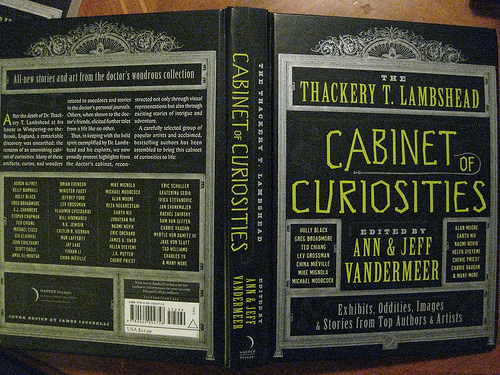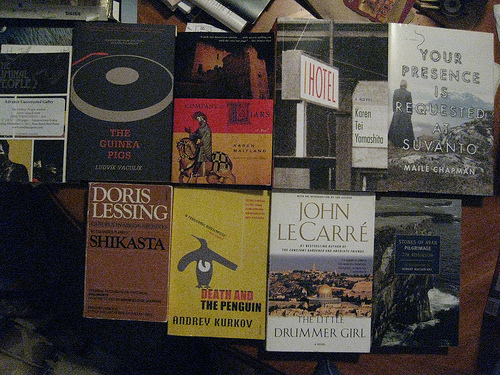Jeff VanderMeer's Blog, page 53
July 6, 2011
The Journals of Doctor Mormeck (Mountain)–Entry #12
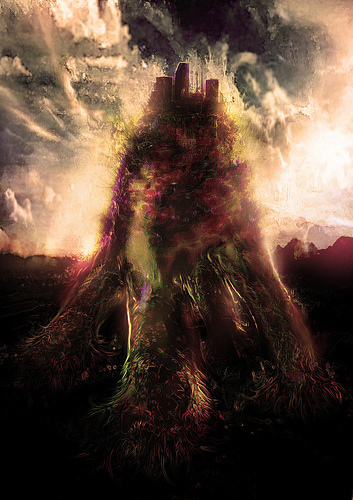
(Mo Ali's awesome visualization of Doctor Mormeck.)
Note: Been reading this serialized long story/novella? Consider supporting a full-time writer. Paypal to vanderworld at hotmail.com. Donations above $21 will entitle you to a free copy of initial anthology or stand-alone book appearance. Context:
Living on a far-distant planet, Doctor Mormeck works for strange beings that might or might not be angels by conducting surveillance across a hundred thousand alt-Earths. When an avatar of Mormeck is sent to a war-torn winter city to investigate a mysterious Presence, the doctor will become embroiled an ever-widening conflict.
Archive is here, Journals of Mormeck, and first entry is here.
Everything that rises must resolve. But when I drift, I drift, and a mountain can drift for a long time. A mountain can drift and still function. This language cannot convey the concept so I must repeat, must keep trying in different ways. I drift, I resolve, I fold inward while turning outward. No, it's no use.
I have continued my surveillance of Marty the lighthouse keeper and the lighthouse itself over the past couple of weeks. I find my cycles of coming down here to the jungle floor to write take ever greater effort, in no small part because Gabriel seems intent on watching me more closely than before. I don't know what this signifies.
Marty and the lighthouse. I knew very early on that this daily routine of walking around the back and kissing a stranger meant something—some kind of code, some kind of message—and that the answer lay in the exchange itself. Something was being communicated, and to find out what I needed to get inside of their mouths, specifically inside of Marty's mouth. I knew this too because although I activated the luna moths' infra-red, x-ray, and other sensory apparatus…at the moment at which lips locked the insides of their mouths went blurry, unseeable. Something was blocking me out.
Spying on someone's mouth. This was a strange idea, frankly, for someone like myself who had no mouth unless I made one, and much more invasive than anything I had done before. However, Gabriel kept asking for updates that went beyond what could be seen from the images the luna moths sent back. He wanted my analysis, and my analysis was that I liked Marty and I liked the lighthouse, and I liked being a part of that life, even if from afar. But that wasn't the answer Gabriel would want.
So I began to scheme about how to get inside of Marty's mouth. One way was drastic and required my moths to descend upon the stranger before he or she approached the lighthouse and cover his/her entire body, taking it over, and then proceeding with the assignation. But not only would this endanger the message from the stranger's side of thing, but Marty might notice the mimicry, which would be approximate only.
I then came up with a number of ever-more impossible schemes, the most elaborate of which required a luna moth at the top of the lighthouse to break off the metamorph tool that formed part of its antennae—at the exact right moment. This tool, smaller than a thumbnail, would glide and tumble down the side of the lighthouse, lingering as necessary or speeding up, just as Marty walked out on her way to the meeting. The luna moth would emit a high-pitched squeal. Marty would look up and if there was even the least parting of her lips, the tool would slip between them. Once inside the mouth, the tool would spread out across the tongue and embed itself, forming an invisible second surface that Marty would not feel in the least. This surface would record every element of the kiss. While she slept, it would disengage, flee through her mouth, and gradually make its way outside to be reunited with the luna moth it had come from. And then the data would be transmitted back to me.
It was, possibly, a ridiculous plan that would have taken several attempts, but the more I fixated on it, the less I had to think about other, more practical solutions. Some of those solutions would require sending angels in, and a subset of those solutions would result in interrogations.
But my problem was more systemic. I had never engaged in this kind of surveillance before. Always I had watched many different people, and skimmed the surface, either moving on or being the invisible eyes and ears in a location, like a restaurant, where many people came and went. Now, I followed one person, Marty, as she followed her daily schedule. I watched her digging furrows in her garden, weeding, and taking a break to drink lemonade and a cookie. I watched her as she mended an old fishing net she sometimes took with her when she waded into the offshore shallows on the weekends. I watched her as she sat on a blanket on the cliff overlooking the sea and guffawed and giggled while reading one of her comedy of manners. I watched her interactions at the pub, and the way she did what she wanted but was never less than kind to anyone, preferring to use a rather sharp and barbed wit to deflate the pompous or the stupid. I watched her patience with a brother who was the opposite of her in so many ways. I watched her stare into the mirror while washing her face and half-hearted pluck at an eyebrow hair. I watched her sing robust sea-shanties in the shower, bellowing them out at the top of her lungs.
I watched and I watched and I watched…and the more I watched, the more I felt ashamed. The less I wanted to be intruding on her personal space. I began to change my process. I had the luna moths send out their own emissaries—tiny gray flies—to cover areas like the bathroom and bedroom of Marty's cottage. I programmed a routine for the flies that meant they only reported back if something out of the ordinary occurred…and it never did. This gave me some distance from Marty, and, unknown to her, more privacy, but the strange way I felt during surveillance didn't really change.
When her birthday came along a week ago, and she celebrated at the pub, I was happy for her, and chuckled inside at some of the antics of her friends. When she received a letter indicating an old friend had passed on, I felt sad with her. And at that point, I moved from surveillance to a different kind of active intervention. I began leaving her messages that were not messages. She liked the feel of small, tight pine cones—the smoothness and the sharp little points—so I converted luna moth metamorph tools into pine cones, a horrible waste of resources, and left them strewn where she could find them on her walks. I used other tools to ensure her garden was pest-free and that her sunflowers and turnips and other vegetables grew strong and robust. If you can imagine a tiny almost-invisible army of bioteched nanobots coming out after dark to tend to a garden.
Most recently, at my most ambitious, I fabricated a decent facsimile of an apple pie and had it left on the doorstep of the lighthouse with a note indicated it was from a "secret admirer". But I watched later and the pie must have been too bitter because she threw it out, and in a moment of utter stupidity I had forgotten she read in English and had written my note in the language of the angels. She kept the note, and puzzled over it often, so perhaps that was a good thing.
But in truth, I am what they call a peeping tom, even if in the service of the angels, and this depresses me.
I am also an intelligent mountain light years and time-streams away from Marty in truth. I am what they call a peeping tom, even if it is in the service of the angels. I am not male or female, but both and neither. To reproduce I fling my self-fertilized mega-seeds up through the stratosphere and into space, where they spend thousands of years dormant before settling on a planet far distant.
The heresy I share here in this secret journal is this: I do not want to know about the mystery of the kisses. I do not care if it is important to Gabriel and the other angels. I do not want a laboratory on my head. I do not want to be a mountain.
I want to live in a cottage beside a lighthouse, by the sea.
And that is impossible.
The Journals of Doctor Mormeck (Mountain)–Entry #12 originally appeared on Ecstatic Days on July 6, 2011.




July 5, 2011
Are You a Librarian Who Blogs? Would You Like a Signed Cabinet of Curiosities?
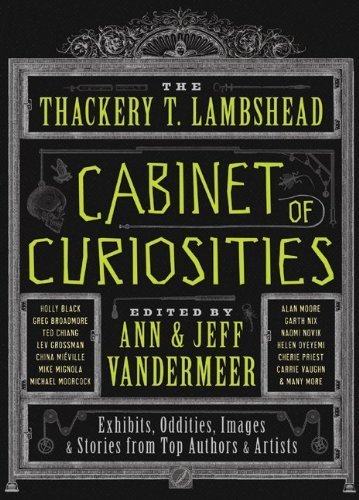
We love librarians—for one thing they always know how to have a good time, for another we always learn something when we hang out with them at ALA or other conferences.
So we're making a special offer for librarians in the United States only (for now): if you're a librarian and you blog about YA and/or adult books—either for a national or regional library website, or have a following on your personal blog—we'd like to send you a free copy of The Thackery Cabinet of Curiosities, signed by both of us editor-types. Offer good for the first ten to respond. Preferably, send us an email at vanderworld at hotmail.com with the URL of the relevant website, although you can post below too as a back-up if you like. All you have to do in return is promise you'll try to blog about the book if you like it.
The cabinet, released soon, is an LA Times recommended summer reading selection that features over 60 pieces of art as well as all-new fiction. Contributors include Holly Black, Greg Broadmore, Ted Chiang, John Coulthart, Rikki Ducornet, Amal El-Mohtar, Minister Faust, Jeffrey Ford, Lev Grossman, N.K. Jemisin, Caitlin R. Kiernan, China Mieville, Mike Mignola, Michael Moorcock, Alan Moore, Garth Nix, Naomi Novik, James A. Owen, Helen Oyeyemi, J.K. Potter, Cherie Priest, Ekaterina Sedia, Jan Svankmajer, Rachel Swirsky, Carrie Vaughn, Jake von Slatt, Tad Williams, Charles Yu, and many more.
Are You a Librarian Who Blogs? Would You Like a Signed Cabinet of Curiosities? originally appeared on Ecstatic Days on July 5, 2011.
Dr. Thackery T. Lambshead: Where Did It All Start? With a Great Quail and a Fake Medical Guide
With features on the new Thackery T. Lambshead Cabinet of Curiosities (pictured above) being posted later this week, it seemed like a good time to get in the old time machine and remember how this all started…with a Great Quail, Mad Quail Disease…and a fake disease guide titled The Thackery T. Lambshead Pocket Guide to Eccentric & Discredited Diseases .
.
The article "How I Became Dr. Lambshead's Medical Assistant", published in 2005 at SF Site, goes into the origins of the fake disease disease guide and how what was meant to be a chapbook blossomed into a unique fiction anthology first published by Night Shade Books and then picked up by Bantam Books (Juliet Ulman, editor). Since the article came out, the anthology has been reprinted in the UK, Greece, and Portugal, with more editions in the works. The original edition was a finalist for the Hugo Award and World Fantasy Award, among others. It's a great example of when something quirky goes viral. Not to mention the ways in which Dr. Lambshead took on a life of his own—something carried over to the new book, as we shall see later in the week.
Generally speaking, this was a Jorge Luis Borges-influenced anthology that took as its main conceit the idea of repurposing nonfictional forms for fiction purposes. You can find a strain of this impulse running throughout the history of books—even including some of Poe's puckish hoaxes—and in the way the line is blurred between the real and the not-real you begin to discover where readers draw the line in receiving high doses of the imagination. We even had an obituary written and sent it around on the book's publication, indicating that possibly the new edition had been the death of him…

(Really? Or did John Coulthart just make it up.)
Most love this sort of thing, and understand it as a highly evolved form of narrative and fictional play—that such framing can enhance a reading experience and doesn't detract from the core fiction. Publishers Weekly wrote, "[The editors] have here created perhaps the oddest theme anthology in the history of fantasy literature. The heavily illustrated volume does exactly what its title implies, collecting short, fictional medical descriptions of such diseases as Ballistic Organ Syndrome, Delusions of Universal Grandeur and Razornail Bone Rot….an amazing book"—among over 120 reviews. Others are offended that such books even exist—how dare you mess with reality that way? (For example, the editor of one yearly best-of books list took the fake disease guide off that list, over the recommendations of best-of contributors, claiming it wasn't really fiction.)
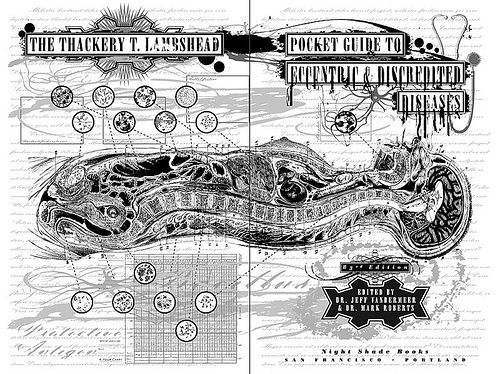
(John Coulthart's original title page)
In the case of the fake disease guide, adopted with relish by medical personnel all over the globe—and still found in the medical guide sections of libraries—the book also blended "genre" and "mainstream" writers and took some writers out of their comfort zone in having to work with more metafictional forms. Readings, as the SF Site article mentions, were really hilarious events for a variety of reasons. (You can also take a look at some of John Coulthart's awesome design for the original edition here and here.)
There were a lot of side benefits—very important ones—to working on this anthology. First, we became accustomed to working with large numbers of contributors and lots of "moving parts". Second, it was the first time we had worked with the amazing John Coulthart, who has gone on to be such an integral part of the books we produce. Without Coulthart, many of our projects would have been much less dynamic or visually appealing. We also discovered a lot of great writers through the process of creating the anthology.

(Greek edition, posing with some awesome Angela Carter!)
Now, why put together a follow-up anthology? Good question, and one you'll get an answer to if you return to this blog on Thursday. But for now, I'll say it wasn't a decision we took lightly. After the success of the fake disease guide, I got offers to edit fake movie guides, fake book guides, and even a second fake disease guide. None of that really appealed, and it wasn't until Ann and I took a hike in 2009 that we finally hit upon a really great idea…
"Mentioned in whispers for decades; burned in Manchuria; worshipped in Peru; the only book to be listed on the Vatican's Index Librorum Prohibitorum twice, for emphasis; available again at last, in this definitive edition. Welcome to the Lambshead Guide. Disease-mongers, shudder." — Dr. China Miéville
Dr. Thackery T. Lambshead: Where Did It All Start? With a Great Quail and a Fake Medical Guide originally appeared on Ecstatic Days on July 5, 2011.
The Journals of Doctor Mormeck's Avatar–Entry #5
Note: Been reading this serialized long story/novella? Consider supporting a full-time writer. Paypal to vanderworld at hotmail.com. Donations above $21 will entitle you to a free copy of initial anthology or stand-alone book appearance. Context:
Living on a far-distant planet, Doctor Mormeck works for strange beings that might or might not be angels by conducting surveillance across a hundred thousand alt-Earths. When an avatar of Mormeck is sent to a war-torn winter city to investigate a mysterious Presence, the doctor will become embroiled an ever-widening conflict.
Archive is here, Journals of Mormeck, and first entry is here.
It has been five or six days. I have had no time to write, and no inclination.
The days and nights have blurred together here, in the winter city by the river. My missions for Pavlov have blurred with my drinking sessions. My Komodo and Mormeck natures have become blurred, too. Something in the maintenance of that body—of becoming a wingless dragon—has changed me. I started out wanting to be gone from this place…but now I find that I enjoy reconnaissance—the rush of it, the terror, the element of the unknown. Even more, my Komodo body responds to it: the stealthy stalking and shadowing, my body invisible or camouflaged to match the surfaces I cling to, scuttle across, or bound through.
I have stood up silent and unmoving, a broken wall against my scaly back and listened to two German sentries discuss the weather and then certain sexual proclivities of their superior officer, which proved useful to Pavlov. I was looming over them, keeping my mouth shut so my hot breath would not wash over them, so close I could have reached out and knocked them over. But they didn't see me. They saw only the wall.
I have, in a burst and release of energy that is pure Komodo, scrambled across the snow at midnight under a yellow moon—well past the rival German and Russian lines, to frolic in cold dark forest and bring down a deer. Komodos have an urge to eat that I cannot control, and if I don't feed on something every few days, I am not myself. And all the while: an exhilaration I never felt as pure Mormeck, a kind of freedom that comes with motion that a mountain cannot fathom, even in avatar form.
As Pavlov has tried harder and harder to follow my own orders, I have tried to follow his, even when this has meant direct action, in part because I believe he is a good person. When the Germans began to bring a "super cannon" into position to fire upon what has now officially become known as "Pavlov's House," I, invisible, smashed into it from the side and sent the soldiers guarding it running off, only for them to later claim, according to my eavesdropping, that there had been a sudden wind. A secret force of white-clad commandoes attempting a nighttime raid found themselves confronted by a translucent raging monster and fled in terror. No one likes to talk about that incident: not a rumor or a breath of it uncovered in my skulking.
I have justified turning from surveillance to intervention because I know that in this alt-world Pavlov's House is never breached, never burned to the ground, and that the German obsession with eliminating his position cost them bitterly on a strategic level. I am merely the personification—the Komodo-ification—of history. I am doing nothing that would not be done by someone.
Yet, as I pad invisible and small along the walls of Pavlov's House on my way to report to Pavlov, I have heard his men talking more and about serendipity and luck in uncertain tones that indicate they don't believe in these things, that although they cannot see me, they can feel my presence, know something is happening that should not be happening..
Meanwhile, Pavlov has had little for me, despite ample proof he has spent quite a bit of political capital getting patrols to be on the look-out for the Presence I seek. We sit across the table in Pavlov's underground office, and I am sure neither of us knows what the other really thinks.
"My friend, we are getting closer to finding your 'Presence'," Pavlov says to me as he downs a shot.
"My friend, we have done good work today," Pavlov says.
"My friend, the Germans are terrified of you," Pavlov says.
But what does he really think? What's going on inside of his head? Does Pavlov secretly believe he is going mad? Does he stay awake at night trying to figure out what I am, where I came from?
I try to see it from his perspective. I try to imagine, for instance, what it would be like if I knew nothing of angels and an angel suddenly appeared before me. What would I have done? Would I have been as calm as Pavlov that first time, and how long would it take for me to start questioning—why this need to search for a Presence, why the willingness to help, why, even, why an enormous dragon would drink with me night after night.
"I believe you," I reply to Pavlov, noncommittally.
"If you say so," I say.
"They are terrified of me," I say, wanting to ask instead, "Aren't you curious? Don't you want to know? Or is it just easier not to?"
***
On what they dare not call Christmas—a holy day for a popular god-cult in this reality—Pavlov's men secretly exchanged presents. If the political officer found out in this, Trotsky's Soviet Union, they could be sent to a work camp. The presents were sad things—loose, frozen tea that one had been saved, given to another who gifted a cufflink found in the snow to yet a third who gave a slice of sausage—and what wasn't drinkable or edible would be gifted back on the next occasion, if they were still here.
Pavlov gave me a delicate gold watch on a chain that displayed the time in several time zones, no doubt taken off the German dead after the latest repulsed assault. I held it in my Komodo claws, feeling suddenly rough and bulky, and a surge of emotion came over me that was straight from Mormeck Mountain. It was a ridiculous present to give a dragon. It displayed a complete misunderstanding of what I had become, but at the same time resonated deeply with Mormeck Avatar. Time was at the heart of everything. No time. Too much time. Divergent time lines.
"I hope you like it, my friend," Pavlov said.
Was I his friend? I had always thought those words just a reflexive quirk of his speech. How could it be otherwise? I was terrifying and inexplicable—even more so if he had met me as Mormeck Mountain.
"Thank you, I do like it…but I am afraid I have nothing for you." Ridiculously, I felt bad and yet even as I uttered those words I realized that I had just revealed to Pavlov more than I had in any previous conversation.
This is Pavlov's House.
Am I becoming Pavlov's Komodo?
The Journals of Doctor Mormeck's Avatar–Entry #5 originally appeared on Ecstatic Days on July 5, 2011.
July 4, 2011
GRRM's Dance with Dragons
Only thing I really didn't get is Tyrion Lannister and most of his kin being flayed alive by the Iron Kings and their skins used to create an airship for the dragon queen to travel to Westeros in. Kinda weird.
GRRM's Dance with Dragons originally appeared on Ecstatic Days on July 4, 2011.




The Weird: Thick Enough to Hurt Ya

(Wot? Are they trying to take our "The" away from us?)
The Weird: A Compendium of Strange and Dark Fictions (Atlantic/Corvus, Oct) is now a huge set of loose-leaf pages in our house.
Well over a ream of paper, printed double-sided.
This (above) is what it looks like as a series of sedimentary layers. That's the history of The Weird in pages, although the pages at the top contain the earliest stories.
We still have to add author notes, the introduction, and the extended copyright page, but it's almost a reality. Kind of hard to believe…
The Weird: Thick Enough to Hurt Ya originally appeared on Ecstatic Days on July 4, 2011.




July 3, 2011
Doctor Mormeck Interlude: Art by Mo Ali
Mormeck is a sentient creature described as a mountain in my ongoing serial fiction "The Journals of Doctor Mormeck." Mo Ali has done the most amazing rendition of Mormeck (above), which I'd be happy to see as the cover of any resulting book, although I may not have control over cover art. Anyway, I think it's absolutely freakin' awesome and am thrilled someone took up the challenge I'd laid down in a prior entry. Even more thrilled that Mo's vision of Mormeck so closely follows my own, so that his art actually inspires me to write more.
The serial will continue on Tuesday.
Doctor Mormeck Interlude: Art by Mo Ali originally appeared on Ecstatic Days on July 3, 2011.
Reading: Books in Progress
For a variety of reasons—travel, project deadlines—I'm actually in the middle of reading several excellent, excellent books. Most I'm more than half-way through and I can recommend all of them on the basis that if each fell apart right now, on the next page I read, I still wouldn't regret picking them up.
I am, however, afraid of them slipping through the cracks in terms of remembering to mention them, so I'm posting ordering links and info below right now, while I'm thinking about it. From top left to right, and then bottom left to right…
The Liminal People by Ayize Jama-Everett—I just got this from Small Beer Press, it's out in December, and it is captivating, interesting style and compelling characters. "When his ex asks for help, Taggert risks the wrath of his enigmatic master to try and save her daughter. But as Taggert realizes the girl has more power than even he can imagine, he has to delve into the very nature of own skills and utilize his heart and soul to survive."
by Ayize Jama-Everett—I just got this from Small Beer Press, it's out in December, and it is captivating, interesting style and compelling characters. "When his ex asks for help, Taggert risks the wrath of his enigmatic master to try and save her daughter. But as Taggert realizes the girl has more power than even he can imagine, he has to delve into the very nature of own skills and utilize his heart and soul to survive."
The Guinea Pigs by Ludvick Vaculik—This is one of those books that starts out humorous and then gets darker with the humor becoming more and more dangerous. Lots of guinea pigs. Quirky, brilliantly written, savage at times. Set in Prague.
by Ludvick Vaculik—This is one of those books that starts out humorous and then gets darker with the humor becoming more and more dangerous. Lots of guinea pigs. Quirky, brilliantly written, savage at times. Set in Prague.
Company of Liars by Karen Maitland—High-quality Medieval England novel about a group of odd travelers trying to avoid the plague, with elements of possible fantasy and definite folktales told along the way. No one is who they seem in this book, and it's written in a style that is modern but does a good job of evoking a Medieval atmosphere. It also seems well-researched without the research slowing the novel down.
by Karen Maitland—High-quality Medieval England novel about a group of odd travelers trying to avoid the plague, with elements of possible fantasy and definite folktales told along the way. No one is who they seem in this book, and it's written in a style that is modern but does a good job of evoking a Medieval atmosphere. It also seems well-researched without the research slowing the novel down.
I Hotel by Karen Tei Yamashita—Half-way through this novel I can say with confidence that unless it totally tanks from here on out it will be one of the most amazing reading experiences I've had in a long, long time. The only reason I haven't finished it yet is I don't want to rush the experience. The technical ability of Yamashita in telling the story through multiple viewpoints and multiple distances from those viewpoints combined with the characterization, the plotting, and the underpinnings of real-life events makes this a very special novel. From the Publishers Weekly starred review: "a stunningly complete vision of San Francisco's Asian American community in the late 1960s and early '70s, using the titular inn as a meeting point for ten loosely-connected novellas, each covering a single year. Focusing on the struggle for equality and peace as it involved this particular community, Yamashita's work also incorporates a broad view of the Asian and Asian American experiences, from Japanese internment camps to the Marcos dictatorship. Yamashita accomplishes a dynamic feat of mimesis by throwing together achingly personal stories of lovers, old men, and orphaned children; able synopses of historical events and social upheaval; and public figures like Lenin and Malcolm X."
by Karen Tei Yamashita—Half-way through this novel I can say with confidence that unless it totally tanks from here on out it will be one of the most amazing reading experiences I've had in a long, long time. The only reason I haven't finished it yet is I don't want to rush the experience. The technical ability of Yamashita in telling the story through multiple viewpoints and multiple distances from those viewpoints combined with the characterization, the plotting, and the underpinnings of real-life events makes this a very special novel. From the Publishers Weekly starred review: "a stunningly complete vision of San Francisco's Asian American community in the late 1960s and early '70s, using the titular inn as a meeting point for ten loosely-connected novellas, each covering a single year. Focusing on the struggle for equality and peace as it involved this particular community, Yamashita's work also incorporates a broad view of the Asian and Asian American experiences, from Japanese internment camps to the Marcos dictatorship. Yamashita accomplishes a dynamic feat of mimesis by throwing together achingly personal stories of lovers, old men, and orphaned children; able synopses of historical events and social upheaval; and public figures like Lenin and Malcolm X."
Your Presence Is Requested at Suvanto by Maile Chapman—I think Chapman is a really, really talented writer, and a third of the way into this atmospheric psychological thriller nothing disproves that notion. Again from PW: "A novelist in search of an appropriate setting for a bleak novel in the 19th-century tradition, where tuberculosis kills thousands and women are routinely deprived their societal voice, would be hard-pressed to find a more fitting venue than the Finnish convalescence ward where Chapman has set her anxious debut. Ex-dancer Julia is a reluctant tenant of the Suvanto Sairaala, attended to by an American nurse named Sunny Taylor with whom she shares an uneasy connection. The two women weather a succession of historical set pieces involving the consequences of imperfectly understood obstetrics, Finland's changing relationship with Russia, and madness."
by Maile Chapman—I think Chapman is a really, really talented writer, and a third of the way into this atmospheric psychological thriller nothing disproves that notion. Again from PW: "A novelist in search of an appropriate setting for a bleak novel in the 19th-century tradition, where tuberculosis kills thousands and women are routinely deprived their societal voice, would be hard-pressed to find a more fitting venue than the Finnish convalescence ward where Chapman has set her anxious debut. Ex-dancer Julia is a reluctant tenant of the Suvanto Sairaala, attended to by an American nurse named Sunny Taylor with whom she shares an uneasy connection. The two women weather a succession of historical set pieces involving the consequences of imperfectly understood obstetrics, Finland's changing relationship with Russia, and madness."
Shikasta (Canopus in Argos: Archives) by Doris Lessing—Well, this one should need no introduction. I had the unfortunate experience of reading book four or five a few years back but not knowing it wasn't the first book, and getting a bit confused. So now I'm going back and starting from the beginning. Truly thought-provoking and world-class stuff.
by Doris Lessing—Well, this one should need no introduction. I had the unfortunate experience of reading book four or five a few years back but not knowing it wasn't the first book, and getting a bit confused. So now I'm going back and starting from the beginning. Truly thought-provoking and world-class stuff.
Death and the Penguin by Andrey Kurkov—Ukrainian writer who gets in over his head with organized crime keeps a penguin in his apartment. Long story. This is one, though, where I'm in the middle of it and there's a tad bit of a lull, which I'll need to motor through to regain interest. Up to this point, I'd been really enjoying it.
by Andrey Kurkov—Ukrainian writer who gets in over his head with organized crime keeps a penguin in his apartment. Long story. This is one, though, where I'm in the middle of it and there's a tad bit of a lull, which I'll need to motor through to regain interest. Up to this point, I'd been really enjoying it.
The Little Drummer Girl by John Le Carre—Yep, another classic. spy story. Convoluted. Complex. Great.
by John Le Carre—Yep, another classic. spy story. Convoluted. Complex. Great.
Stones of Aran: Pilgrimage by Tim Robinson—If you want to restore your soul, this book is a good place to start. It's a spiritual experience, and you cannot read it in snippets—you must engage in immersive, hours-long reading. From PW: "An exquisitely detailed portrait of a special landscape, this is a gem-like addition to the travel genre. Robinson, an artist and cartographer, has made prize-winning maps of southwest Ireland and adjacent islands. Describing himself as "self-appointed resident scientific busybody," he walks the coastline of Arainn, largest of the three Aran Islands, clockwise from the western edge, in an exploration of geology, topography, history, language and folklore. Arainn is limestone, and its natural forms are rectilinear. We see storm beaches–mile after mile of huge boulders stripped from the rim of cliffs and moved inland by wind. Robinson recounts hazardous sports once practiced by the natives–birdcatching and fishing from clifftops; he calls our attention to prehistoric sites and to abandoned forts. He takes a side trip by curragh to the Brannock Islands and meditates on the origins of placenames. Arainn's north coast was a center for kelp factories producing iodine and fertilizer in the 19th century; Robinson offers a vivid picture of that period as well."
by Tim Robinson—If you want to restore your soul, this book is a good place to start. It's a spiritual experience, and you cannot read it in snippets—you must engage in immersive, hours-long reading. From PW: "An exquisitely detailed portrait of a special landscape, this is a gem-like addition to the travel genre. Robinson, an artist and cartographer, has made prize-winning maps of southwest Ireland and adjacent islands. Describing himself as "self-appointed resident scientific busybody," he walks the coastline of Arainn, largest of the three Aran Islands, clockwise from the western edge, in an exploration of geology, topography, history, language and folklore. Arainn is limestone, and its natural forms are rectilinear. We see storm beaches–mile after mile of huge boulders stripped from the rim of cliffs and moved inland by wind. Robinson recounts hazardous sports once practiced by the natives–birdcatching and fishing from clifftops; he calls our attention to prehistoric sites and to abandoned forts. He takes a side trip by curragh to the Brannock Islands and meditates on the origins of placenames. Arainn's north coast was a center for kelp factories producing iodine and fertilizer in the 19th century; Robinson offers a vivid picture of that period as well."
Reading: Books in Progress originally appeared on Ecstatic Days on July 3, 2011.
Common Ground
This post by Tricia Sullivan, and comments by Liz Williams among others, is useful and necessary. Scorched-earth polemics can't be the default reaction to stimuli, in part because they lead us no closer to solutions. Inflamed rhetoric, righteousness, and rigid ideologies of any type tend to corrode communication and thus obscure facts and analysis. We need more analysis. We need more facts. We also need to find ways to build community, and a sense of community, while we do it. Trust, and asking for trust, on the internet, may seem difficult at times, but it's something we should strive for whenever possible.
I'd suggest posting over on Sullivan's comment thread to add to that discussion. Here, I say simply: if there's a great anthology or other project you think does a good job of representing writing by women, why not take some time to praise the editors/creators/contributors on your blog or livejournal? We need to recognize that praise goes a long way toward improving morale and energizing people and lifting them up. Public praise also helps signal boost what we love, and make it more likely that what we love will, to put it bluntly, sell well enough to enable more such projects.
Common Ground originally appeared on Ecstatic Days on July 3, 2011.
July 2, 2011
Mord, Interviewed About Appearing in Novel "Borne"
Mord appears in Borne, the short novel I'm working on. In the novel, Mord is a huge floating bear-creature terrorizing a ruined post-apocalyptic city in which an anonymous dysfunctional Company still creates bioneered creatures for places far-distant that haven't yet become failed states. The thing known as "Borne" is found by the viewpoint character, Rachel, who lives in a trap-strewn fortified underground stronghold called the Balcony Cliffs with Wick, a rogue bioneer who left the Company a few years ago.
I thought it might be interesting to interview Mord about the experience of appearing in the novel.
Has it been fun being in the novel so far?
MORD HATE NOVEL. MORD HATE YOU. MORD CRACK BONES, EAT MARROW.
Is it true you were once human?
MORD IS MORD.
How accurately do you think the novel depicts your character?
MORD NOT MURDERER. MORD NOT RAGING FOOL. MORD NOT "RUINING CITY".
But at last count, you had killed over four thousand people. How do you explain these actions?
MORD HUNGRY. MORD ONLY KILL FOR FOOD.
Doesn't the Company feed you?
MORD ALSO KILL BECAUSE MORD DEPRESSED. MORD DEPRESSED AND ANGRY AND WANT OUT OF NOVEL. (SOMETIMES MORD KILL FOR FUN. SOMETIMES MORD JUST SIT DOWN SUDDENLY AND KILL PEOPLE BY ACCIDENT.)
Is that really an excuse?
MORD NOT CARE.
If you found a child playing near a river, what would you do?
MORD DUNK CHILD IN RIVER FOR FLAVOR. MORD EAT CHILD. MORD USED BONES AS TOOTHPICK.
What do you think of Borne?
MORD THINK BORNE POSER. MORD HATE BORNE. MORD EAT BORNE IF FIND BORNE. MORD CRUNCH BORNE BONES IF BORNE HAD BONES BUT BORNE COWARD AND HAS NO BONES. BONELESS BASTARD BORNE.
Read anything good lately?
MORD READ LORD OF FLIES. THEN MORD EAT LORD OF FLIES.
What is your philosophy of life?
MORD FORCE MULTITUDES AGREE WITH MORD AND JOIN MORD IN BATTLE. MORD NEVER KNEEL. MORD NEVER BEG FOR MERCY. MORD CANNOT DIE AND WILL FIGHT ON FOREVER.
Finally, what do you find beautiful?
MORD FIND YOUR ENTRAILS BEAUTIFUL.
Mord, Interviewed About Appearing in Novel "Borne" originally appeared on Ecstatic Days on July 2, 2011.

